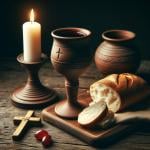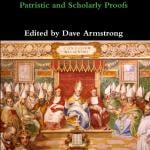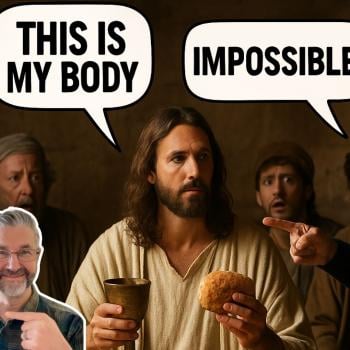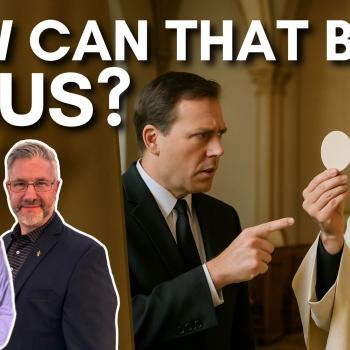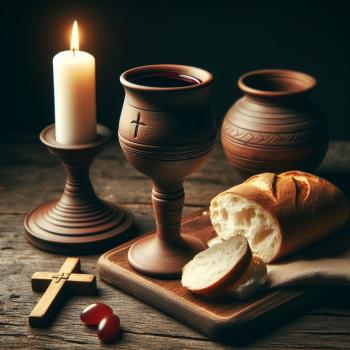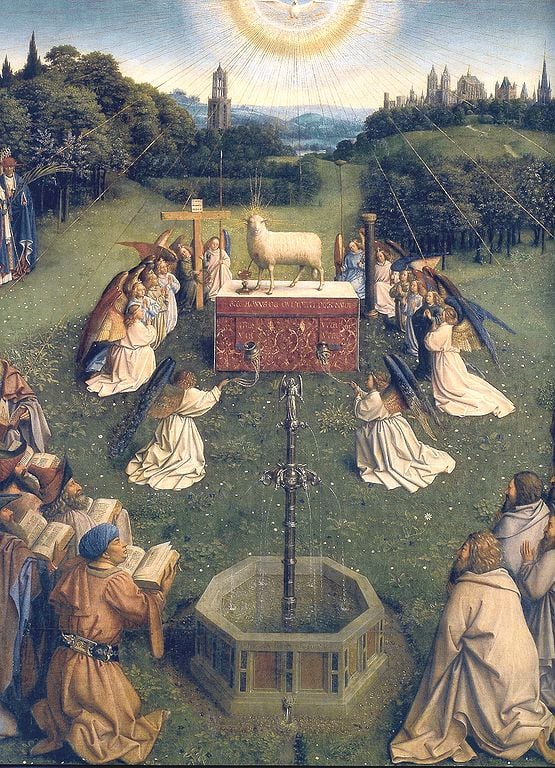
I’m inspired by the fabulous performance of Catholic Answers apologist Joe Heschmeyer vs. Bishop “Dr.” [???] James White in the recent debate, “Is the Mass A Propitiatory Sacrifice?” Joe pointed out how Protestants look the death of the Jesus on the cross as a one-time event (as indeed it was), but in a way that precludes a revisiting of it in the Mass. But then he noted how there was a difference in the Old Testament sacrificial system between the sacrifice itself and the offering of the sacrifice to God (all of it being part of the same overall process of worship). On the Day of Atonement, known by Jews as Yom Kippur, we see the procedure of the sacrifice, according to Mosaic Law:
Leviticus 16:11-16 (RSV) “Aaron shall present the bull as a sin offering for himself, and shall make atonement for himself and for his house; he shall kill the bull as a sin offering for himself. [12] And he shall take a censer full of coals of fire from the altar before the LORD, and two handfuls of sweet incense beaten small; and he shall bring it within the veil [13] and put the incense on the fire before the LORD, that the cloud of the incense may cover the mercy seat which is upon the testimony, lest he die; [14] and he shall take some of the blood of the bull, and sprinkle it with his finger on the front of the mercy seat, and before the mercy seat he shall sprinkle the blood with his finger seven times. [15] “Then he shall kill the goat of the sin offering which is for the people, and bring its blood within the veil, and do with its blood as he did with the blood of the bull, sprinkling it upon the mercy seat and before the mercy seat; [16] thus he shall make atonement for the holy place, because of the uncleannesses of the people of Israel, and because of their transgressions, all their sins;
First, the sacrifice was made by the high priest, and then blood was taken from it (both from a bull and a goat) into the Holy of Holies (the holiest part — the inner sanctum — of the temple, and the tabernacle, prior to the temple) and sprinkled onto the mercy seat between the two cherubim, which was above the ark of the covenant, where God was specially present (Ex 30:6: “. . . the mercy seat that is over the testimony, where I will meet with you”). Hence, the second “offering” to God was separate and distinct from the sacrifice of the animals. Before God gave Moses the Law on Mt. Sinai, in Egypt, before the exodus, the feast of Passover was a simpler form of the same sort of sacrifice:
Exodus 12:5-8, 13-14 Your lamb shall be without blemish, a male a year old; you shall take it from the sheep or from the goats; [6] and you shall keep it until the fourteenth day of this month, when the whole assembly of the congregation of Israel shall kill their lambs in the evening. [7] Then they shall take some of the blood, and put it on the two doorposts and the lintel of the houses in which they eat them. [8] They shall eat the flesh that night, roasted; with unleavened bread and bitter herbs they shall eat it. . . . [13] The blood shall be a sign for you, upon the houses where you are; and when I see the blood, I will pass over you, and no plague shall fall upon you to destroy you, when I smite the land of Egypt. [14] “This day shall be for you a memorial day, and you shall keep it as a feast to the LORD; throughout your generations you shall observe it as an ordinance for ever.
The New Testament then picks up this theme and applies it to the redemptive sacrifice of Jesus on our behalf:
John 1:29, 36 The next day he saw Jesus coming toward him, and said, “Behold, the Lamb of God, who takes away the sin of the world! . . . [36] and he looked at Jesus as he walked, and said, “Behold, the Lamb of God!”
Acts 8:32 Now the passage of the scripture which he was reading was this: “As a sheep led to the slaughter or a lamb before its shearer is dumb,
so he opens not his mouth. [this was from the Old Testament passage below]Isaiah 53:4-7 Surely he has borne our griefs and carried our sorrows; yet we esteemed him stricken, smitten by God, and afflicted. [5] But he was wounded for our transgressions, he was bruised for our iniquities; upon him was the chastisement that made us whole, and with his stripes we are healed. [6] All we like sheep have gone astray; we have turned every one to his own way; and the LORD has laid on him the iniquity of us all. [7] He was oppressed, and he was afflicted, yet he opened not his mouth; like a lamb that is led to the slaughter, and like a sheep that before its shearers is dumb, so he opened not his mouth.
1 Corinthians 5:7 . . . Christ, our paschal lamb, has been sacrificed.
1 Peter 1:19 . . . the precious blood of Christ, like that of a lamb without blemish or spot.
Hebrews 2:17 Therefore he had to be made like his brethren in every respect, so that he might become a merciful and faithful high priest in the service of God, to make expiation for the sins of the people.*Hebrews 5:5-6 So also Christ did not exalt himself to be made a high priest, but was appointed by him who said to him, “Thou art my Son, today I have begotten thee”; [6] as he says also in another place, “Thou art a priest for ever, after the order of Melchiz’edek.” (cf. 6:20)*Hebrews 7:26-28 For it was fitting that we should have such a high priest, holy, blameless, unstained, separated from sinners, exalted above the heavens. [27] He has no need, like those high priests, to offer sacrifices daily, first for his own sins and then for those of the people; he did this once for all when he offered up himself. [28] Indeed, the law appoints men in their weakness as high priests, but the word of the oath, which came later than the law, appoints a Son who has been made perfect for ever.*Hebrews 9:11-14 But when Christ appeared as a high priest of the good things that have come, then through the greater and more perfect tent (not made with hands, that is, not of this creation) [12] he entered once for all into the Holy Place, taking not the blood of goats and calves but his own blood, thus securing an eternal redemption. [13] For if the sprinkling of defiled persons with the blood of goats and bulls and with the ashes of a heifer sanctifies for the purification of the flesh, [14] how much more shall the blood of Christ, who through the eternal Spirit offered himself without blemish to God, purify your conscience from dead works to serve the living God. [15] Therefore he is the mediator of a new covenant, so that those who are called may receive the promised eternal inheritance, since a death has occurred which redeems them from the transgressions under the first covenant.*Hebrews 9:24-26 For Christ has entered, not into a sanctuary made with hands, a copy of the true one, but into heaven itself, now to appear in the presence of God on our behalf. [25] Nor was it to offer himself repeatedly, as the high priest enters the Holy Place yearly with blood not his own; [26] for then he would have had to suffer repeatedly since the foundation of the world. But as it is, he has appeared once for all at the end of the age to put away sin by the sacrifice of himself.*Hebrews 10:10 . . . we have been sanctified through the offering of the body of Jesus Christ once for all.
Hebrews 5:1, 3 For every high priest chosen from among men is appointed to act on behalf of men in relation to God, to offer gifts and sacrifices for sins. . . . [3] . . . he is bound to offer sacrifice for his own sins as well as for those of the people.*Hebrews 8:3 . . . every high priest is appointed to offer gifts and sacrifices . . .*Hebrews 9:6-7 These preparations having thus been made, the priests go continually into the outer tent, performing their ritual duties; [7] but into the second only the high priest goes, and he but once a year, and not without taking blood which he offers for himself and for the errors of the people
Hebrews 10:11-14 And every priest stands daily at his service, offering repeatedly the same sacrifices, which can never take away sins. [12] But when Christ had offered for all time a single sacrifice for sins, he sat down at the right hand of God, [13] then to wait until his enemies should be made a stool for his feet. [14] For by a single offering he has perfected for all time those who are sanctified. (cf. 8:1: “we have such a high priest, one who is seated at the right hand of the throne”)
My most vivid memory of the first Mass I attended was that powerful moment in the Communion Rite where the people say, “Lamb of God, who takes away the sin of the world, have mercy on us.” “Lamb of God.” “Lamb of God.” Then they knelt, and the priest held up the host and said, “Behold the Lamb of God who takes away the sins of the world”—that was “Lamb of God” four times in less than a minute.
I was sitting in the back pew as simply an observer. But suddenly I knew where I was: I was back in the Book of Revelation where Jesus is called the Lamb of God no less than 28 times in 22 chapters. He’s only called “Lamb” in one other book in the entire New Testament: the Gospel of John, and there just twice. But in the Apocalypse, that’s his main title, more than all the other titles: Lord of Lords, King of Kings, Alpha and Omega, and all the rest. He’s the Lamb of God.
I went back to Mass the next day. I had my pad and pencil, and I had my Bible. This time I had it open to Revelation and I saw things I’d never seen before. I saw a connection in these liturgical actions. Not just one or two. Not even just eight or ten. I made a list of 30 elements: white-robed priests, an altar, a congregation chanting “Holy, holy, holy,” the alleluias, the amen, the golden chalices, the book, the invocation of angels and saints. I hardly knew which way to turn—toward the actions on the pages of the Apocalypse, or the action up at the altar. After about 15 or 20 minutes of the second Mass, suddenly I realized they were one and the same action. What I was reading on the page was exactly what I was watching up there at the altar.
Revelation 5:6-12 And between the throne and the four living creatures and among the elders, I saw a Lamb standing, as though it had been slain, with seven horns and with seven eyes, which are the seven spirits of God sent out into all the earth; [7] and he went and took the scroll from the right hand of him who was seated on the throne. [8] And when he had taken the scroll, the four living creatures and the twenty-four elders fell down before the Lamb, each holding a harp, and with golden bowls full of incense, which are the prayers of the saints; [9] and they sang a new song, saying, “Worthy art thou to take the scroll and to open its seals, for thou wast slain and by thy blood didst ransom men for God from every tribe and tongue and people and nation, [10] and hast made them a kingdom and priests to our God, and they shall reign on earth.” [11] Then I looked, and I heard around the throne and the living creatures and the elders the voice of many angels, numbering myriads of myriads and thousands of thousands, [12] saying with a loud voice, “Worthy is the Lamb who was slain, to receive power and wealth and wisdom and might and honor and glory and blessing!” (cf. 13:8: “the Lamb that was slain”; 7:14 and 12:11: “the blood of the Lamb”; 22:3: “the throne of God and of the Lamb shall be in it, and his servants shall worship him”)
Revelation 6:15-17 Then the kings of the earth and the great men and the generals and the rich and the strong, and every one, slave and free, hid in the caves and among the rocks of the mountains, [16] calling to the mountains and rocks, “Fall on us and hide us from the face of him who is seated on the throne, and from the wrath of the Lamb; [17] for the great day of their wrath has come, and who can stand before it?”*Revelation 14:1 Then I looked, and lo, on Mount Zion stood the Lamb, and with him a hundred and forty-four thousand who had his name and his Father’s name written on their foreheads.*Revelation 14:9-11 And another angel, a third, followed them, saying with a loud voice, “If any one worships the beast and its image, and receives a mark on his forehead or on his hand, [10] he also shall drink the wine of God’s wrath, poured unmixed into the cup of his anger, and he shall be tormented with fire and sulphur in the presence of the holy angels and in the presence of the Lamb. [11] And the smoke of their torment goes up for ever and ever; and they have no rest, day or night, these worshipers of the beast and its image, and whoever receives the mark of its name.”*Revelation 17:14 they will make war on the Lamb, and the Lamb will conquer them, for he is Lord of lords and King of kings, . . .*Revelation 19:9 . . . “Blessed are those who are invited to the marriage supper of the Lamb.” . . .*Revelation 22:1-3 Then he showed me the river of the water of life, bright as crystal, flowing from the throne of God and of the Lamb [2] through the middle of the street of the city; also, on either side of the river, the tree of life with its twelve kinds of fruit, yielding its fruit each month; and the leaves of the tree were for the healing of the nations. [3] There shall no more be anything accursed, but the throne of God and of the Lamb shall be in it, and his servants shall worship him;
In general, this period, . . . was already very strongly inclined toward the doctrine of transubstantiation, and toward the Greek and Roman sacrifice of the mass, which are inseparable in so far as a real sacrifice requires the real presence of the victim…… (Philip Schaff, History of the Christian Church, vol. 3, A. D. 311-600, revised 5th edition, Grand Rapids, Michigan: Eerdmans, reprinted 1974, originally 1910, p. 500)
*
***
*
Photo credit: Adoration of the Mystic Lamb, detail of the Ghent Altarpiece, c. 1432, by Jan van Eyck (c. 1390-1441) [public domain / Wikimedia Commons]
Summary: I highlight many remarkable corroborating passages in the books of Hebrews and Revelation, related to the miraculous timeless & sacrificial aspect of the Catholic Mass.


